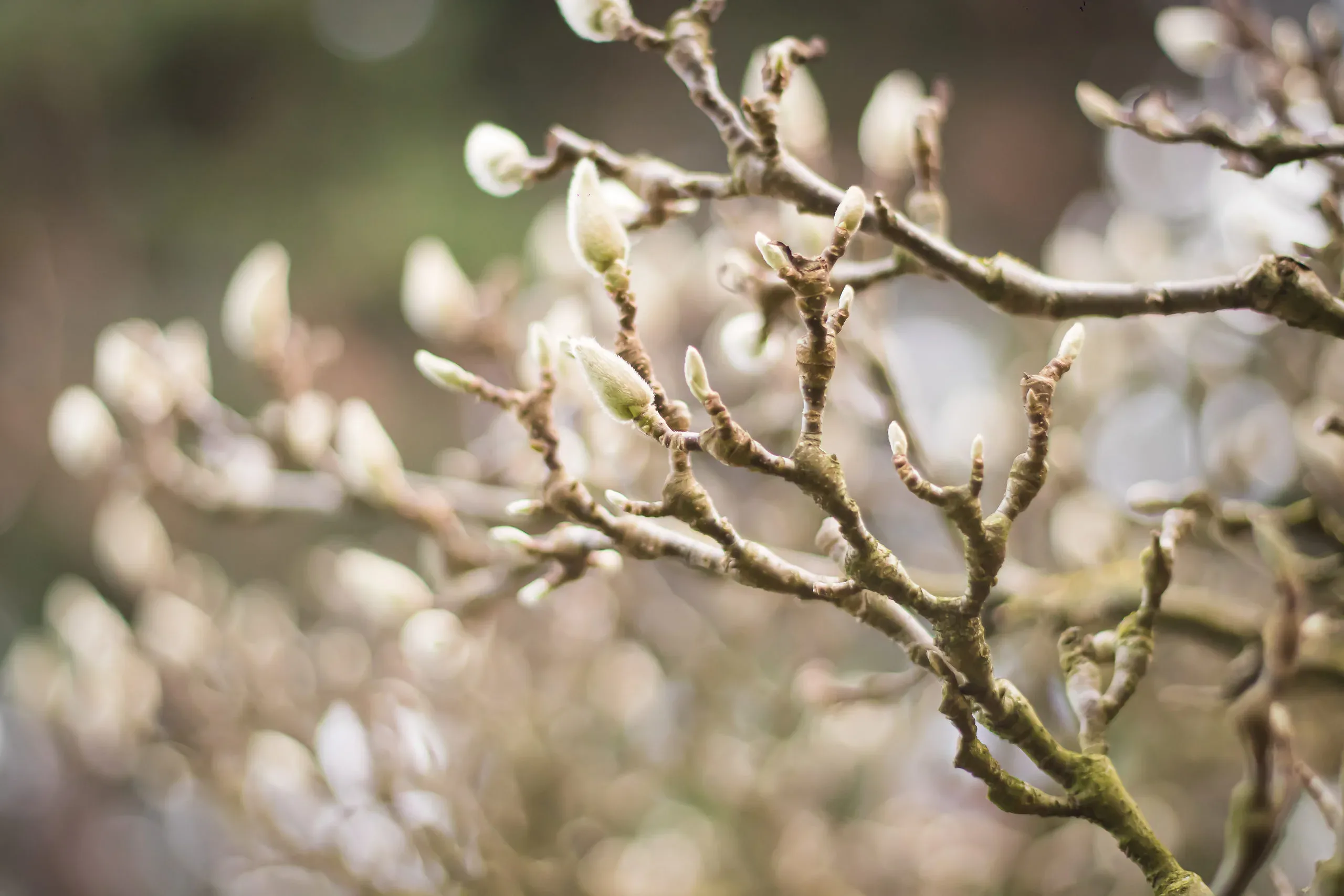
Planting Guides How to Plant Deciduous Trees
Deciduous trees lose their foliage during winter, bursting to life with new growth once spring arrives. Many types of deciduous trees bring color to an otherwise dull landscape in fall with their brilliant leaf colors in hues of purple, yellow, orange and red. Now that you have received your potted deciduous tree, it is important to prepare and plant it properly so it will give you years of healthy growth and enjoyment. Continue reading because our guide will give you all the general tips necessary to prepare the site and plant your potted tree, giving it the best start possible in your landscape.
Note: If the tree you received is not in a plastic pot, please check our planting guides concerning Ball & Burlap and bare rooted trees. There you will find all the tips necessary for success planting those trees.
In a Nutshell
– Remove all packaging
– Water the tree in its pot
– Choose a suitable planting site based on the needs of your tree
– Prepare the soil
– Dig a hole the depth of the pot
– Prepare the roots to prevent girdling
– Put the tree in its hole and replace most of the soil
– Water well, let the water drain and put back the remainder of the soil
– Put mulch around the tree and water weekly for the first season
Getting Your Deciduous Tree Ready to Plant
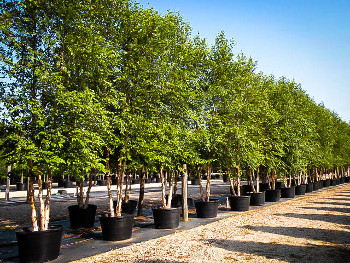
If you received your tree during winter and the ground in your area isn’t frozen, do not stress because winter is still an appropriate season to plant your tree. If your tree has only bare limbs, remember, it’s a deciduous tree and they drop their foliage during the winter months – it will grow new leaves again in the spring.
When it comes to transferring your tree to a waiting location until you are ready to plant, move it by the container and not by lifting the tree by its trunk or branches, as you can cause damage.
Care Before Planting Time
Once your deciduous trees are unpacked and unwrapped, move them into a shady location and not to an enclosed area such as your home or garage, regardless if the outdoor temperatures are cold. Your tree is hardy to your winter weather conditions so it will be fine as is. After moving the tree to its temporary location in your garden, water it well and until you see it flowing from the container’s bottom drain holes. This assures that the root ball is sufficiently watered.
Do not remove the tree from its pot until you are ready to plant. It will reside quite happily in its container until this time, provided you water when the top inch of soil feels dry. Do not allow the soil to completely dry out, so check it regularly until it is planted in your landscape. Depending on the preferred light conditions of your particular tree, you can move it to a sunnier location after several days once it has adjusted to the new environment and recovered from shipping.
Choosing a Planting Location
It is not good for the tree’s health to move it around once it is planted, so decide where it can permanently grow based on its needs. The things you need to consider when selecting a suitable site are the tree’s light requirements and its mature size. You do not want to plant a tree that requires full sun for the majority of the day in a shady site or it will never perform well. Likewise, you do not want to plant a tree that performs best in shade in a site receiving the full rays of the sun. Check our site for the description of your tree and you will find its lighting needs, as well as other important details.
Knowing the expected mature size of your tree is also an important factor when selecting an appropriate site. You do not want to plant directly on your property line, as your neighbor has the right to trim the branches that overhang into his yard. In addition, you do not want to plant it too close to a structure where falling branches can cause potential damage or under power lines. You want a site where the tree can reach its full potential without interference.
If you are planting multiple trees for the creation of windbreaks, privacy screens or a tall-growing hedge, please check our special planting guides that cover how to properly plant trees in these situations.
Preparing the Planting Site
Preparing your planting site’s soil properly can make the difference in a robustly growing tree and one that just hangs onto life. Once you have chosen an appropriate location for your deciduous tree, the first thing you will want to do is clear the planting site of any weeds or grasses, which will rob the tree of moisture and nutrients.
You can pull the unwanted vegetation from the site with your hands or use a hard rake. However, if you decide to use an herbicide, allow the product to work at least two weeks before planting. Before you plant, remove all the dead debris from the site, including any large rocks. Clear a site that is at least 3 feet in diameter so there’s no possibility of the trunk becoming damaged from lawn equipment bumping into it.
Once you have cleared the site of the unwanted vegetation, you can now amend the native soil with organic materials such as well-rotted manure or compost. Even if your native soil is sandy and lacks fertility, do not be compelled to bring in soil from another location, but instead, add nutrients by amending with organic materials.
Spread a 6-8 inch layer of the organic material over the planting site and work it into the area to a depth of about 12 inches. This not only adds fertility to the area, but also loosens the soil, which allows the tree’s roots system and easier time spreading out and establishing itself and assists in drainage.
Preparing the Deciduous Tree
Preparing your deciduous tree for planting is basic. The night before you plan on planting, just water it well and until you see the water flowing from the bottom of the container. You do not want to plant it if its root ball is completely dry.
Digging the Hole
Now that you have prepped the area, it is time to dig the hole. Dig a hole that is several times wider than the pot and just as deep. You do not want to plant the deciduous tree too deep because it puts undue stress on it as it tries to establish itself. However, if you find you have dug the hole too deep, you can correct the problem when you go to plant the tree.
Removing the Pot
Once you have your planting hole prepared it’s time to remove the pot holding your deciduous tree. Depending on the size of the tree, you might require the help of another person to hold the tree while you remove its pot. Generally, tapping on the pot’s sides releases the root ball and the tree slides easily from the container. However, if the pot is stubborn and does not easily release from the root ball, you can cut away the bottom, place the remainder of the pot in the hole when you begin to plant, and cut down the sides to release the pot from the tree’s root ball.
Preventing Root Girdling
Tree girdling is when roots wrap around the trunk and chokes off the water and nutrients that flow from the root system and into the upper portion of the tree. Girdling weakens the trunk and the tree slowly declines, leading to its premature death. Normal tree trunks flare out at their base, but a girdled trunk’s base can be narrower than the upper portion of it, and can also look sunken or flattened.
Major causes of tree girdling is planting the tree too deep, forcing the root system into a hole that is too small for it, and root systems that are wrapping around each other and planted with the circular wrapping intact. If you remove the deciduous tree from its pot and see that the roots have filled the container and are wrapping around each other you need to alleviate the problem before planting the tree.
If the root system is still pliable, you can pull it apart with your hands so the roots spread outward and not in a circle. In addition, you can take a clean knife and cut through the roots that are circling, which forces them to grow outward. Whatever you do, do not plant the tree with wrapping roots or your tree will most likely suffer growth problems and possible death.
Planting Your Deciduous Tree
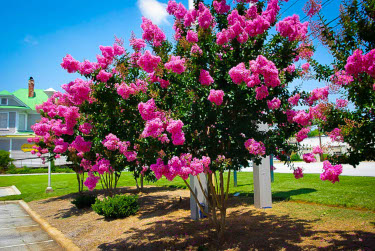
If the hole is a bit too deep, gently lift the tree from the hole and place the amount of soil needed in the hole to raise the tree up to the level it was originally growing inside the pot.
Planting in Clay or Heavy Soils
Heavy soils such as clay have a tendency to remain wet, which can lead to problems with root rot with your deciduous tree. You can cure the problem by making sure the heavy soil has plenty of compost or well-rotted manure worked into the area, which assists with drainage and creating a mound. Form a mound that is about a foot tall, before planting the tree, as this raises the root system out of the wet conditions.
Watering the Tree
Before you finish filling the hole, give the root system another good soaking by filling the hole with water. This will also help settle the soil around the root system. Allow the water to drain completely from the hole before you complete the planting process.
Finishing the Planting
Once the water has completely drained from the hole, fill the remainder of the hole with soil. Firm the soil up around the base of the tree by using your foot and make sure the area is level and does not slant downward away from the trunk, which will have the water running away from the root system and the tree won’t be properly watered.
If you desire, you can create about a 4-inch soil dam around the planting site that will keep the water in place over the root system and not having it run off into the yard. Once planted, apply a 3-4 inch layer of organic mulch over the planting site, keeping it several inches away from the trunk. This helps the soil retain moisture and cuts down on unwanted vegetative growth. Once you have applied the mulch, water the area again, saturating the root system.
Staking Pot-Grown Deciduous Trees
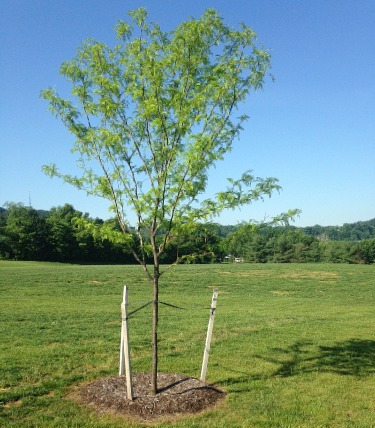
When staking your tree you will need two stakes that are around 5 feet tall, a hammer and tree staking straps or another soft material like canvas strapping. Do not use ropes or wire as it can damage the tree by cutting into the trunk.
Place the stakes on opposite sides of the tree and about 1.5 feet from the tree’s root ball. Hammer the stakes into the ground about 18 inches and place the straps around the tree and then around the stake in a figure eight position. This allows the trunk some leeway as it moves with wind. You do not want to tie the rope tightly and directly around the trunk or damage can occur.
Follow-up Care of Pot-Grown Deciduous Trees
It can take three or four months for your deciduous tree’s root system to establish itself into its new planting site, so it requires regular water. For the first few months after planting, plan to water twice weekly. Watering deeply is better than a light sprinkling as it reaches the roots and allows them to grow deep in the soil. After the first few months and depending on your weather, you can reduce watering to once each week. However, if your weather is hot and dry, you may have to water the tree several times each week.
Replace the organic mulch each spring and fertilize with a blend for your particular tree, following package directions on amounts and frequency of use. By following a few basic steps in preparing your pot-grown deciduous tree for its new site, you are sure to have a healthy and robustly growing tree for years to come, gracing your landscape with its beauty.[/vc_column_text][/vc_column][/vc_row]
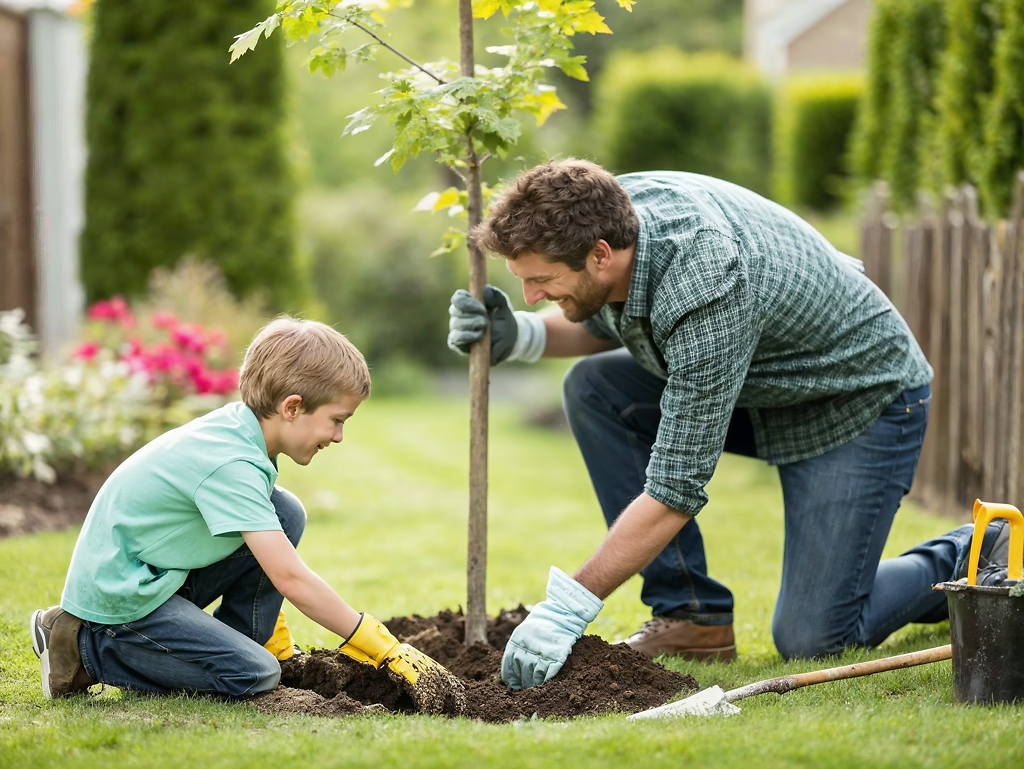
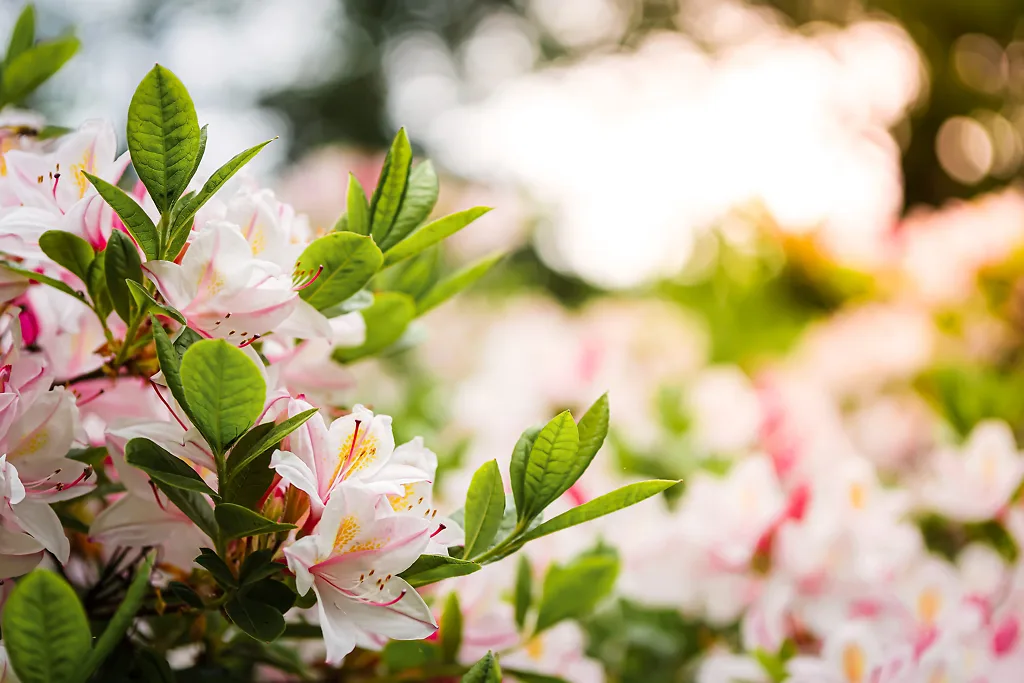






Comments 24 comments
I’m looking to buy two red maples to replace two other tress that were diseased and were cut down. I live in Maryland, and the county requires me to plant minimum 1″ caliper trees. What caliper are the red maples you ship, please?
I live in central Florida – Orlando. What species are best for our climate?
do you have breesetrees
Great info. Very helpful! Big THANKS
i have 3 acres of land . used to be farmed so i have no trees. it gets windy . how should i start my process in planting my future of my land
Do I remove the support pole my Japanese Emperor Maple is taped to?
What trees are best for soggy soil and also that are not buffets for deer?
im trying to find green ash or white ash with no luck and i have a friend who would like a black jack or a black gum tree are we crazy or is there such things
Thank you for this great guide. I wasn’t aware of girlish or the proper planting and this is a great assist!
I purchased a crepe myrtle shrub, “Enduring Summer” in July 2020. It was doing fine. But now it is losing its leaves. I gave it a little trim yesterday. I live in zone 10, Naples,FL. I read in the newspaper that now is a good time to fertilize trees and shrubs. What type of fertilizer should I use? I have a bag of 8-4-8 for my gardenia, etc. Is this ok to use? and is it normal for it to go bare at this time? Please contact me at 239-206-1595. Thank you.
I need to know what my zone is ? I have a small yard but need to know which trees 🌲 are best ? I live in castle rock colo.
Please when it’s the best month for plant my maple tree thanks
Our tree has already died what do we do now?
WE LIVE IN COLORADO SPRINGS. WE WANT TO PLANT 2 BRANDYWINE RED MAPLES AND A ROYAL PURPLE SMOKE TREE.
IS IT TOO LATE IN THE SEASON TO PLANT THESE TRESS IN JULY?
I have seen some commercial sites that have trees planted have put a corrugated pipe down into the ground (for watering?). Can anyone say if this is beneficial for plants trees?
with a new tree, do you charge by the size of the tree? and what would the cost of a 4 foot flowering tee be?
I’m interested a Seiryu Japanese Maple for my back yard, but I’m wondering if it will survive w/only min. morning sunlight and min. to none at all in the afternoon.
Excellent Info! Thank you for this!!!
One thing not mentioned is to make sure your tree is planted level – growing perfectly vertical. A level will assist you in making sure. Or just stand back, before backfilling the hole, and look at the tree from several different angles.
What is the best time of year to plant deciduous trees in eastern NC???
I have planted a few Thula Green Giant about 69 days past.
I have perhaps over fertilized or put in a spot too low and wet.
It is on its last leg and I would like to send you a photo ?
I want to replace it and thought you may have a suggested alternative ?
I have planted a few Thula Green Giant about 69 days past.
I have perhaps over fertilized or put in a spot too low and wet.
It is on its last leg and I would like to send you a photo ?
I want to replace it and thought you may have a suggested alternative ?
I have planted a few Thula Green Giant about 69 days past.
I have perhaps over fertilized or put in a spot too low and wet.
It is on its last leg and I would like to send you a photo ?
I want to replace it and thought you may have a suggested alternative ?
I have planted a few Thula Green Giant about 69 days past.
I have perhaps over fertilized or put in a spot too low and wet.
It is on its last leg and I would like to send you a photo ?
I want to replace it and thought you may have a suggested alternative ?